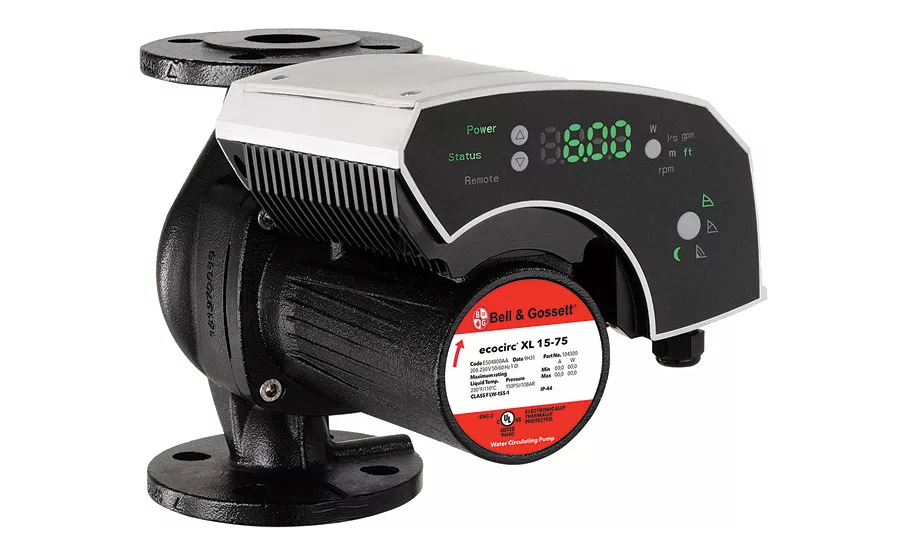Smart circulators drive down energy costs
The amount of energy consumed by the building sector has grown dramatically over the past 50 years.

With the introduction of smart system solutions and looming regulatory guidelines, circulators like this Bell & Gossett ecocirc XL circulator will continue to be of interest in 2017 and beyond. Photo credit: Bell & Gossett, a Xylem brand

It is a best practice to make sure the drains are clean before you leave the job to reduce recalls and lower expenses. Photo credit: Mr. Rooter
The amount of energy consumed by the building sector has grown dramatically over the past 50 years — from 25% of U.S. annual electricity consumption in the 1950s to more than 76% in 2012, according to www.Energy.gov.
Because heating, ventilation and air conditioning consume the largest amount of energy in buildings, it’s critical for consulting-specifying engineers and contractors to select and install smart, efficient pumps to reduce the amount of energy needed to meet occupant heating and cooling needs.
However, it is important to remember that highly efficient and technologically advanced components of HVAC systems, such as circulator pumps, do not by themselves make a heating or cooling system efficient. Each component must be designed, installed and operated as part of the complete system in order to increase system efficiency while addressing heating and cooling needs. For circulators, this means pump speed will adjust to meet fluctuating system demands, thus operating at higher levels of efficiency over a broader range of operating conditions.
With the introduction of smart system solutions and looming regulatory guidelines, circulators will continue to be of interest in 2017 and beyond.
Smart features
Today’s circulators are designed with more functionality and intelligence than ever before, enabling them to react to occupant behavior and tailor energy and resource consumption to efficiently meet system demands. They contain advanced analytics generated by integrating drives that incorporate algorithms to enable the circulator to monitor its power requirements and automatically adjust to meet system demands.
Many large circulators contain BACnet capability, which enables them to be linked to a building management system (BMS) to increase communication with other building systems.
Earlier this year, Xylem’s Bell & Gossett brand previewed a SMART heating circulator at the 2017 International Air-Conditioning, Heating and Refrigerating Exposition. The circulator is designed with a proportional pressure control that automatically adjusts pump performance to meet the requirements of the heating system and step-less speed control to set the pump performance to meet individual system requirements. It also contains electronically commutated motors (ECM) to reduce energy consumption by up to 50%. In addition to the 19-16 SMART heating circulator, Bell & Gossett offers the ecocirc, ecocirc XL and ecocirc XL 3-phase, which come standard with ECM motors.
Conservation standards
The most efficient circulators on the market contain ECM technology. And, if the regulations currently under consideration by the U.S. Department of Energy (DOE) become law, all circulators will be required to come standard with ECM.
According to the Plumbing-Heating-Cooling Contractors — National Association, some circulator pumps have wire-to-water efficiency levels as low as 15%. New technologies that come standard with ECM increase pump efficiency.
On Nov. 30, 2016, the Appliance Federal Rulemaking Advisory Committee (ASRAC) working group made up of Hydraulic Institute members and pump manufacturer representatives, including representatives from Xylem, negotiated a final term sheet that contains a test procedure and energy conservation standards for circulator pumps and presented it to the DOE.
While no timeline has been established, it is expected that these standards would not go in effect earlier than 2021. If the DOE publishes the test procedure and energy conservation standards, it will issue a notice of proposed rulemaking, or NOPR, before the final rule. Manufacturers will receive a four-year compliance period during which they must upgrade circulators to meet the new standards or retire inefficient products.
ECM circulators have already begun replacing circulators with induction motors in the marketplace because permanent magnet motors are the technology of choice to achieve higher efficiency — helping to boost system performance by up to 85%. Circulators with variable-speed capability provide greater system control and flexibility compared to constant-speed circulators.
ECM circulators can quickly and easily be programmed and feature an interface that clearly displays the flow rate, head, speed and power consumption. They also include a permanent magnet in the motor to help reduce friction losses in the circulator pump and quicker start up in a system.
Rebate programs
Massachusetts and a number of other states have implemented rebate programs to incentivize the installation of smart pumps in homes and commercial buildings to help residents and businesses manage energy use and drive down energy costs.
Mass Save, an initiative sponsored by Massachusetts’ natural gas and electric utilities and energy efficiency service providers, provides technical assistance and financial incentives — up to $100 at the time of purchase — for qualifying ECM circulator pumps at the wholesale level. Bell & Gossett ecocirc XL models qualify for the rebate program. To learn more about rebate programs and eligible products, contact a local contractor or sales representative.
In years to come, circulators will continue to play a key role in driving down energy costs by reacting to occupant behavior and tailoring energy use to meet system demands.
Looking for a reprint of this article?
From high-res PDFs to custom plaques, order your copy today!






